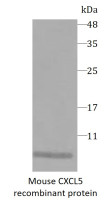ARG70438
Mouse CXCL5 recombinant protein (Active) (His-tagged, N-ter)
Mouse CXCL5 recombinant protein (Active) (His-tagged, N-ter) for SDS-PAGE
Overview
| Product Description | E. coli expressed, His-tagged (N-ter) Active Mouse CXCL5 recombinant protein |
|---|---|
| Tested Application | SDS-PAGE |
| Target Name | CXCL5 |
| Species | Mouse |
| A.A. Sequence | Val1 - Ala118 |
| Expression System | E. coli |
| Protein Full Name | C-X-C motif chemokine 5 |
| Activity | Active |
| Activity Note | Determined by its ability to chemoattract BaF3 cells transfected with human CXCR2. The ED50 for this effect is < 100 ng/mL. |
| Alternate Names | CXCL5; C-X-C Motif Chemokine Ligand 5; ENA-78; SCYB5; Small Inducible Cytokine Subfamily B (Cys-X-Cys), Member 5 (Epithelial-Derived Neutrophil-Activating Peptide 78); Epithelial-Derived Neutrophil-Activating Protein 78; Neutrophil-Activating Peptide ENA-78 |
Properties
| Form | Powder |
|---|---|
| Purification Note | Endotoxin level is less than 0.1 EU/µg of the protein, as determined by the LAL test. |
| Purity | > 98% (by SDS-PAGE) |
| Buffer | PBS (pH 7.4) |
| Reconstitution | It is recommended to reconstitute the lyophilized protein in sterile water to a concentration not less than 200 μg/mL and incubate the stock solution for at least 20 min at room temperature to make sure the protein is dissolved completely. |
| Storage Instruction | For long term, lyophilized protein should be stored at -20°C or -80°C. After reconstitution, aliquot and store at -20°C or -80°C for up to one month. Storage in frost free freezers is not recommended. Avoid repeated freeze/thaw cycles. Suggest spin the vial prior to opening. |
| Note | For laboratory research only, not for drug, diagnostic or other use. |
Bioinformation
| Gene Symbol | CXCL5 |
|---|---|
| Gene Full Name | C-X-C Motif Chemokine Ligand 5 |
| Background | This gene encodes a protein that is a member of the CXC subfamily of chemokines. Chemokines, which recruit and activate leukocytes, are classified by function (inflammatory or homeostatic) or by structure. This protein is proposed to bind the G-protein coupled receptor chemokine (C-X-C motif) receptor 2 to recruit neutrophils, to promote angiogenesis and to remodel connective tissues. This protein is thought to play a role in cancer cell proliferation, migration, and invasion. |
| Function | Involved in neutrophil activation. In vitro, ENA-78(8-78) and ENA-78(9-78) show a threefold higher chemotactic activity for neutrophil granulocytes. |
| Cellular Localization | Secreted |
| PTM | Disulfide bond |
Images (1) Click the Picture to Zoom In






